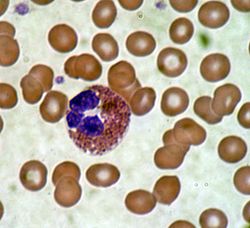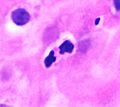Eosinophil granulocyte facts for kids
Quick facts for kids Eosinophil granulocyte |
|
|---|---|
 |
|
| Eosinophil under the microscope (400x) from a peripheral blood smear. Red blood cells surround the eosinophil, two platelets at the top left corner. | |
| Code | TH H2.00.04.1.02017 |
Eosinophils are a special type of white blood cell. They are like tiny soldiers in your body, helping to fight off certain parasites and infections. Eosinophils are also involved in allergys and asthma.
Contents
What are Eosinophils?
Eosinophils are a kind of granulocyte, which is a group of white blood cells. These cells are found in the blood of vertebrates, including humans. They are very important for keeping you healthy.
You usually have a small number of eosinophils in your blood. They make up about 1% to 6% of all your white blood cells.
How Eosinophils Work
When eosinophils find something harmful, like a parasite, they get active. They release a mix of special proteins from tiny sacs inside them called granules. These proteins help to destroy the invaders.
Eosinophils are especially good at fighting large, multi-cellular parasites. This includes things like worms and flukes. If you have a parasitic infection, your body will often make more eosinophils to help fight it off.
Eosinophils and Allergies
Sometimes, eosinophils can cause problems. Along with other cells like mast cells and basophils, they play a role in allergys and asthma. In these conditions, eosinophils can react to harmless things, causing symptoms like sneezing, itching, or breathing difficulties.
What Eosinophils Look Like
Eosinophils are similar in size to other white blood cells called neutrophils. But if you look at them under a microscope, they have some unique features. When stained with a special dye called eosin, their granules look reddish-orange. They also have a nucleus that often looks like it has two parts.
Images for kids
-
Histology of an eosinophil within epithelium, characterized by its bilobed nucleus despite scant visible eosinophilic cytoplasm.
See also
 In Spanish: Eosinófilo para niños
In Spanish: Eosinófilo para niños


